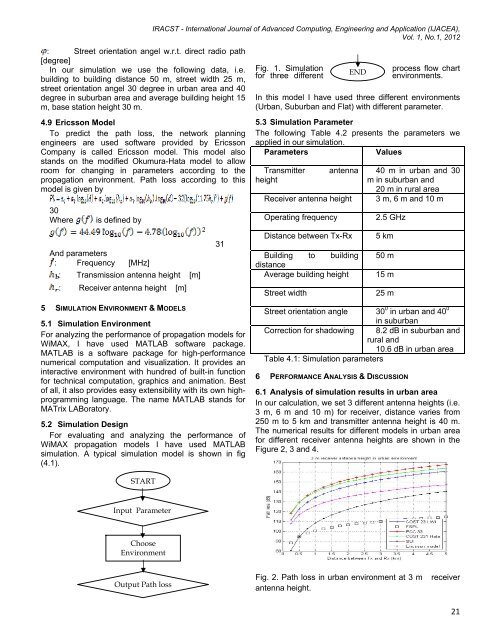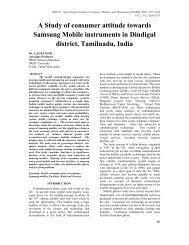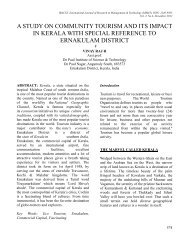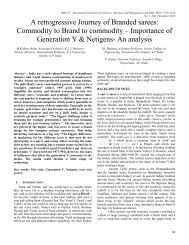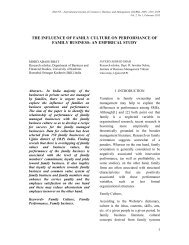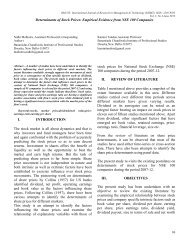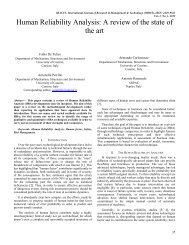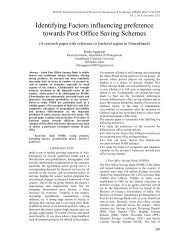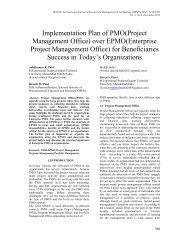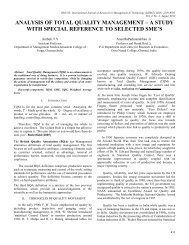evaluation and performance analysis of propagation models for wimax
evaluation and performance analysis of propagation models for wimax
evaluation and performance analysis of propagation models for wimax
You also want an ePaper? Increase the reach of your titles
YUMPU automatically turns print PDFs into web optimized ePapers that Google loves.
: Street orientation angel w.r.t. direct radio path[degree]In our simulation we use the following data, i.e.building to building distance 50 m, street width 25 m,street orientation angel 30 degree in urban area <strong>and</strong> 40degree in suburban area <strong>and</strong> average building height 15m, base station height 30 m.4.9 Ericsson ModelTo predict the path loss, the network planningengineers are used s<strong>of</strong>tware provided by EricssonCompany is called Ericsson model. This model alsost<strong>and</strong>s on the modified Okumura-Hata model to allowroom <strong>for</strong> changing in parameters according to the<strong>propagation</strong> environment. Path loss according to thismodel is given by30Whereis defined byIRACST - International Journal <strong>of</strong> Advanced Computing, Engineering <strong>and</strong> Application (IJACEA),Vol. 1, No.1, 2012Fig. 1. Simulation<strong>for</strong> three differentprocess flow chartenvironments.In this model I have used three different environments(Urban, Suburban <strong>and</strong> Flat) with different parameter.5.3 Simulation ParameterThe following Table 4.2 presents the parameters weapplied in our simulation.ParametersValuesTransmitterheightantennaReceiver antenna heightOperating frequencyEND40 m in urban <strong>and</strong> 30m in suburban <strong>and</strong>20 m in rural area3 m, 6 m <strong>and</strong> 10 m2.5 GHzAnd parameters: Frequency [MHz]: Transmission antenna height [m]: Receiver antenna height [m]31Distance between Tx-RxBuilding to buildingdistanceAverage building heightStreet width5 km50 m15 m25 m5 SIMULATION ENVIRONMENT & MODELS5.1 Simulation EnvironmentFor analyzing the <strong>per<strong>for</strong>mance</strong> <strong>of</strong> <strong>propagation</strong> <strong>models</strong> <strong>for</strong>WiMAX, I have used MATLAB s<strong>of</strong>tware package.MATLAB is a s<strong>of</strong>tware package <strong>for</strong> high-<strong>per<strong>for</strong>mance</strong>numerical computation <strong>and</strong> visualization. It provides aninteractive environment with hundred <strong>of</strong> built-in function<strong>for</strong> technical computation, graphics <strong>and</strong> animation. Best<strong>of</strong> all, it also provides easy extensibility with its own highprogramminglanguage. The name MATLAB st<strong>and</strong>s <strong>for</strong>MATrix LABoratory.5.2 Simulation DesignFor evaluating <strong>and</strong> analyzing the <strong>per<strong>for</strong>mance</strong> <strong>of</strong>WiMAX <strong>propagation</strong> <strong>models</strong> I have used MATLABsimulation. A typical simulation model is shown in fig(4.1).Street orientation angle 30 0 in urban <strong>and</strong> 40 0in suburbanCorrection <strong>for</strong> shadowing 8.2 dB in suburban <strong>and</strong>rural <strong>and</strong>10.6 dB in urban areaTable 4.1: Simulation parameters6 PERFORMANCE ANALYSIS & DISCUSSION6.1 Analysis <strong>of</strong> simulation results in urban areaIn our calculation, we set 3 different antenna heights (i.e.3 m, 6 m <strong>and</strong> 10 m) <strong>for</strong> receiver, distance varies from250 m to 5 km <strong>and</strong> transmitter antenna height is 40 m.The numerical results <strong>for</strong> different <strong>models</strong> in urban area<strong>for</strong> different receiver antenna heights are shown in theFigure 2, 3 <strong>and</strong> 4.STARTInput ParameterChooseEnvironmentOutput Path lossFig. 2. Path loss in urban environment at 3 m receiverantenna height.21


